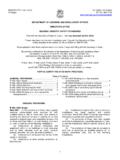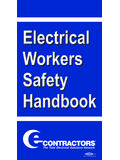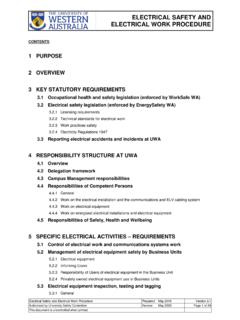Transcription of DEPARTMENT OF HEALTH AND HUMAN SERVICES
1 DEPARTMENT OF HEALTH AND HUMAN SERVICESC enters for Disease Control and PreventionNational Institute for Occupational Safety and HealthThis document is in the public domain and may be freely copied or of any company or product does not constitute endorsement by the National Institute for Occupational Safety and HEALTH (NIOSH). In addition, citations to Web sites external to NIOSH do not constitute NIOSH endorsement of the sponsoring organizations or their pro-grams or products. Furthermore, NIOSH is not responsible for the content of these Web sites. All Web addresses referenced in this document were accessible as of the publication INFORMATIONThis document is in the public domain and may be freely copied or reprinted.
2 To receive NIOSH documents or more information about occupational safety and HEALTH topics, contact NIOSH at1 800 CDC INFO (1 800 232 4636) TTY: 1 888 232 6348 E-mail: visit the NIOSH Web site at a monthly update on news at NIOSH, subscribe to NIOSH eNews by visiting (NIOSH) Publication Number 2009 113 (supersedes 2002 123)April 2009 Safer Healthier People ForewordThe National Institute for Occupational Safety and HEALTH (NIOSH) esti-mates that 230,000 young workers under the age of 18 suffer work - related injuries in the United States each year. Young and new workers have a high risk for work - related injury compared with more experienced workers.
3 Occupational safety and HEALTH training remains a fundamental element of hazard control in the workplace, and there is great potential to reduce these incidents through pre-employment training. Effective pre-employment training should include realistic environments and hands-on exercises. However, NIOSH recommends that actual employment in the electrical trades or any of the other construction trades be delayed until individuals reach the minimum age of student manual is part of a safety and HEALTH curriculum for secondary and post-secondary electrical trades courses. The manual is designed to engage the learner in recognizing, evaluating, and controlling hazards associ-ated with electrical work .
4 It was developed through extensive research with vocational instructors, and we are grateful for their valuable M. Branche, Acting Director National Institute for Occupational Safety and HEALTH Centers for Disease Control and Prevention iiiAcknowledgmentsThis document was prepared by Thaddeus W. Fowler, and Karen K. Miles, , Education and Information Division (EID) of the National Institute for Occupational Safety and HEALTH (NIOSH). Editorial SERVICES were provided by John W. Diether and Rodger L. Tatken. Pauline Elliott, Gino Fazio, and Vanessa Becks provided layout and design authors wish to thank John Palassis and Diana Flaherty (NIOSH), Robert Nester (formerly of NIOSH), and participating teachers and stu-dents for their contributions to the development of this document.
5 This document was updated by Michael McCann, , CIH, Director of Safety Research, CPWR-Center for Construction Research and Training and Carol M. Stephenson, , ContentsPageSection 1 .. 1 Electricity Is Dangerous .. 1 How Is an Electrical Shock Received?.. 2 Summary of Section 1 .. 5 Section 2 .. 6 Dangers of Electrical Shock .. 6 Summary of Section 2 .. 11 Section 3 .. 12 Burns Caused by 12 Arc Blasts .. 12 Electrical Fires .. 14 Summary of Section 3 .. 15 First Aid Fact Sheet .. 16 Section 4 .. 18 Overview of the Safety 18 What Must Be Done to Be Safe? .. 18 Summary of Section 4 .. 21 Section 5.
6 22 Safety Model Stage 1 Recognizing 22 How Do You Recognize Hazards?.. 22 Summary of Section 5 .. 35 Section 6 .. 36 Safety Model Stage 2 Evaluating 36 How Do You Evaluate Your Risk?.. 36 Summary of Section 6 .. 37 Section 7 .. 38 Safety Model Stage 3 Controlling Hazards: Safe work Environment .. 38 How Do You Control Hazards? .. 38 How Do You Create a Safe work Environment?.. 38 Lock out and tag out circuits and 39 Lock-out/tag-out checklist .. 40 Control inadequate wiring 41 Control hazards of fixed wiring .. 42 Control hazards of flexible wiring .. 42 Use flexible wiring properly .. 42 vPage Use the right extension cord.
7 44 Control hazards of exposed live electrical parts: isolate energized 45 Control hazards of exposure to live electrical wires: use proper 46 Control hazards of shocking 48 Ground circuits and equipment .. 48 Use GFCIs .. 50 Bond components to assure grounding path .. 51 Control overload current 52 When You Must work on or Near Live Circuits .. 54 Live- work Permit 54 Summary of Section 7 .. 56 Section 8 .. 58 Safety Model Stage 3 Controlling Hazards: Safe work 58 How Do You work Safely? .. 58 Plan your work and plan for safety .. 59 Ladder safety fact sheet .. 62 Avoid wet working conditions and other dangers.
8 65 Avoid overhead powerlines .. 65 Use proper wiring and connectors .. 65 Use and maintain tools 68 Wear correct PPE .. 70 PPE fact 72 Summary of Section 8 .. 75 Glossary of Terms .. 78 Appendix .. 79 Index .. 80 Photo and Graphics 81vi Section 1 Page 1 Section 1 Electricity Is DangerousWhenever you work with power tools or on electrical circuits, there is a risk of electrical hazards, especially electrical shock. Anyone can be exposed to these hazards at home or at work . Workers are exposed to more hazards because job sites can be cluttered with tools and materials, fast-paced, and open to the weather.
9 Risk is also higher at work because many jobs involve electric power tools. Electrical trades workers must pay special attention to electrical haz-ards because they work on electrical circuits. Coming in contact with an electrical voltage can cause current to flow through the body, resulting in electrical shock and burns. Serious injury or even death may occur. As a source of energy, electricity is used without much thought about the hazards it can cause. Because electricity is a famil-iar part of our lives, it often is not treated with enough caution. As a result, an average of one worker is electrocuted on the job every day of every year!
10 According to the Bureau of Labor Statistics Census of Fatal Occupational Injuries Research File for 1992 2005, electrocution is the fifth leading cause of work - related deaths for 16- to 19-year-olds, after motor vehicle deaths, contact with objects and equipment, work -place homicide, and falls. Electrocution is the cause of 7% of all workplace deaths among young workers aged 16 19, causing an average of 10 deaths per Electrical shock may cause injury or death!Electrical SafetyElectrical work can be deadly if not done to the learner This manual describes the hazards of electrical work and basic approaches to working safely.
















